Kazakhstan, a name that once whispered tales of nomadic tribes and the ancient Silk Road, is a place not on the radar of most travelers, and is almost unknown besides the silly and offensive connection to Borat. But this place now beckons to the modern explorer with promises of untamed landscapes, heart-pounding adventures, and, believe it or not, a culinary odyssey that offer some of the most interesting and adventurous eats I’ve had in quite some time. If you’re thinking about traveling here, you’ll definitely want to get up to speed on Kazakhstan food and some of the delicious (and strange) dishes you might encounter when visiting.
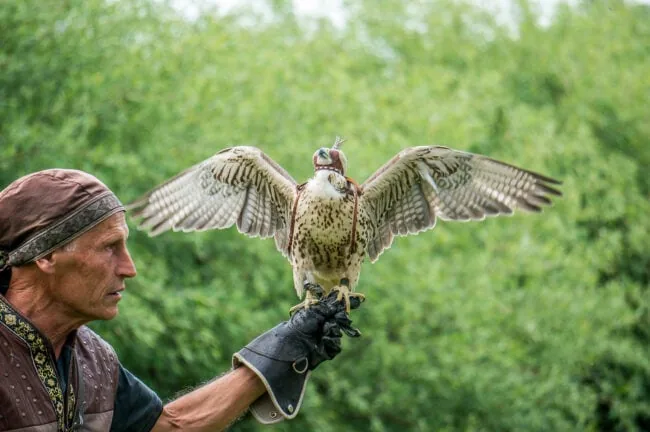
But before we dive into the captivating world of Kazakh cuisine, let’s set the stage. Kazakhstan, the world’s largest landlocked country (and 9th largest country in the world), is a haven for adventure seekers. From the rugged peaks of the Tian Shan Mountains to the endless steppes that stretch beyond the horizon, it’s a playground for those who yearn to get off the beaten path, rediscover a sense of adventure in the travels, and experience the incredible landscapes on offer here in the great outdoors.
Now, you might be wondering why I have strayed so far from my familiar terrain exploring Latin America and living as an expat in Colombia. Well, I was fortunate enough to be invited to explore this country as part of the SATW (Society of American Travel Writers) in partnership with Travel Kazakhstan and USAID to explore this country and get a taste of what it has to offer the adventurous traveler, as part of a small group of amazing travel writers from North America.

BUT it’s precisely this departure from the beaten path that keeps the travel flame alive within me. While I’ve hiked in dense tropical jungles, scaled icy peaks in the Andes, and danced to the rhythms of salsa in Medellin, Kazakhstan represents a fresh canvas on which to paint new memories, a place where the thrill of discovery is as intoxicating as the altitude of its Tian Shan mountains.
And, of course, there’s the food. Traditional Kazakhstan food, sometimes overshadowed by its more renowned neighbors throughout Central Asia, holds its own when it comes to flavor, tradition, and cultural significance. This is a cuisine born of nomadic roots, shaped by its history, and infused with influences from its seat at the crossroads of civilizations, with influences from the Silk Road to the Soviet Union, but grounded in its traditions from the Steppe. It’s a culinary journey I embarked on with eagerness and intrigue, ready to savor every bite, try things that I’ve never had before, and share every delectable detail with you, my fellow gastronomic adventurers. Food is truly one of the best parts of travel.

So, fasten your seatbelts, put on your hiking boots, and join me to explore Kazakhstan’s hidden treasures, both in its stunning landscapes and on its diverse dinner plates. In the sections that follow, I’ll take you on a journey through the best foods to eat in Kazakhstan, from the perspective of a traveler who’s ventured far and wide but has found an entirely new world here in the heart of Central Asia. Let’s get to it!
Traditional Kazakhstan Food
In the heart of Kazakhstan, where the winds whisper tales of nomadic heritage, you’ll find a treasure trove of traditional Kazakh cuisine that not only satisfy the palate but also tell stories of a rich and diverse history. These are the flavors that have sustained generations of nomads, and they are a testament to the resilience and ingenuity of Kazakh people and their cuisine.
Beshbarmak (Five Fingers):
Ingredients: Beshbarmak (or beshparmak), which translates to “Five Fingers,” is a celebratory dish made with boiled meat (usually lamb or beef), served atop flat noodles and accompanied by onions. It’s a simple yet hearty dish, that I absolutely loved and ate on more than one occasion during my stay. This is probably the most popular Kazakh dish and is actually the national dish of Kazakhstan — so be sure to try it, I think you’ll love it.

Preparation: The meat is boiled until tender, then sliced and placed on a bed of noodles. Onions are often sprinkled on top.
Flavors: The flavors are savory and comforting, with the meat’s richness complemented by the mild, flat noodles. The onions add a subtle bite.
Baursak:
Ingredients: Baursak is a fried dough pastry made from flour, eggs, and milk. It’s shaped into small, bite-sized pieces before frying.
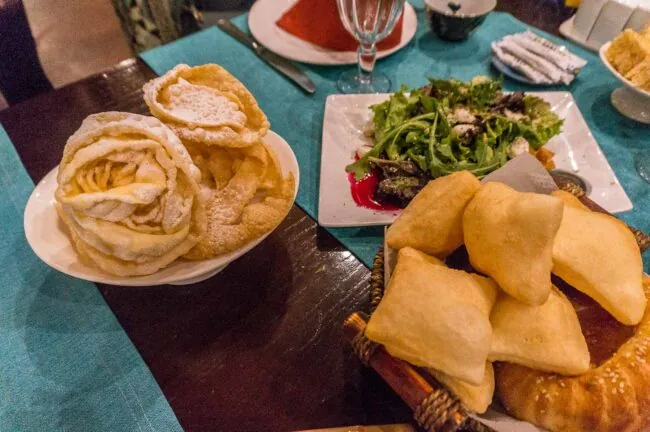
Preparation: The dough is kneaded and shaped into small squares, then deep-fried until golden brown.
Flavors: Baursak is crispy on the outside and soft on the inside, with a subtle sweetness. It’s often served as an appetizer, snack, or with tea.
Baursak, the unexpected sleeper hit of my culinary adventure! Literally everyone in our group was raving about Baursak and we’d practically fight over these delicious golden morsels that would magically appear on the table (and then disappear just as fast). They’re addictive, to say the least. Definitely a top food, and one that I could see myself making at home on occasion. I miss them already!
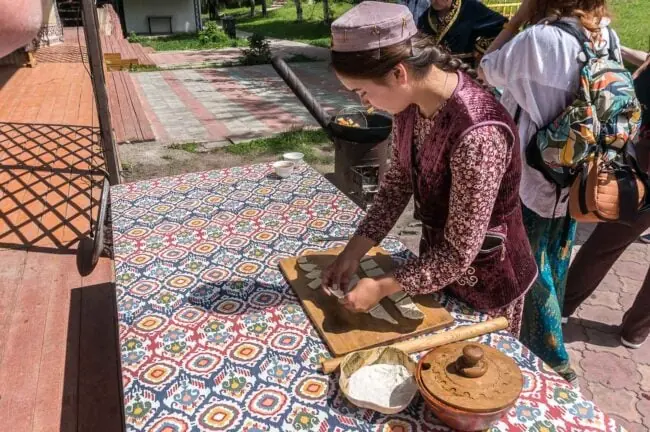
Baursak is even better when they are freshly fried and still warm. On a few occasions we were privileged enough to get them right after being prepared and even to see them roll out the dough, cut them up into squares and toss it in the roiling oil.
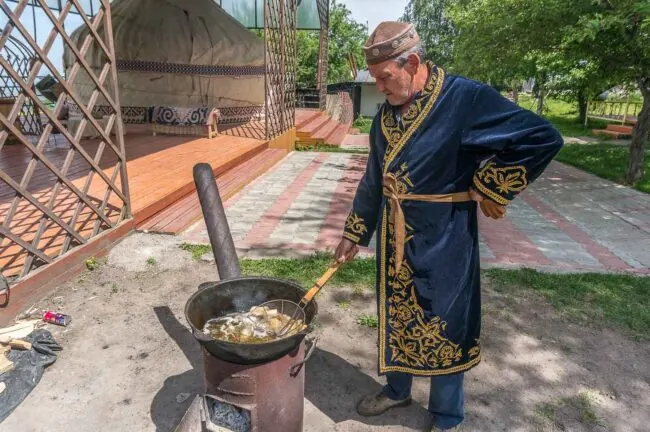
Laghman:
Ingredients: Laghman is another hearty noodle dish featuring hand-pulled noodles, stir-fried meat (typically beef or lamb), and a medley of vegetables.
Preparation: The key to Laghman is the hand-pulled noodles, which are stretched and cooked to perfection. The meat and vegetables are stir-fried and served atop the noodles.
Flavors: Laghman is a harmonious blend of textures and flavors, with the chewy noodles, savory meat, and crisp vegetables coming together in a delightful medley.
My first time trying laghman was also the first meal that really blew me away in Kazakhstan and made me say WOW. We pulled into a small, non-descript roadside restaurant in a dusty town on the way to Charyn Canyon, but the result was a deliciously satisfying bowl of noodles that warmed my soul and was another huge hit with everyone in our group. Laghman is actually a Uyghur dish which is another Central Asian group of people that are actually quite close to Almaty, just across the border in modern-day China.
Shashlik (Kebabs):
Ingredients: Shashlik consists of marinated and skewered pieces of meat, often lamb or beef.
Preparation: The meat is marinated with a mixture of spices and sometimes yogurt, then skewered and grilled over an open flame.
Flavors: Shashlik is smoky, tender, and bursting with the flavors of the marinade. It’s often served with flatbread and a side of vegetables.
Manti (Dumplings):
Ingredients: Manti are dumplings filled with ground meat (typically lamb or beef), onions, and spices. They are often steamed or baked.

Preparation: The dough is rolled out thin, and a small portion of the meat mixture is placed in the center. The dumplings are then folded into various shapes and cooked.
Flavors: Manti are a burst of flavor in every bite, with the savory meat mixture complemented by the delicate dough. They are often served with a spicy sauce.
Plov (Pilaf):
Ingredients: Plov is a fragrant rice dish cooked with meat (usually lamb or beef), carrots, onions, and spices.

Preparation: The meat and vegetables are sautéed, then rice is added and cooked together with flavorful spices.
Flavors: Plov is a symphony of flavors and aromas, with each grain of rice infused with the essence of the spices and tender meat.
Kazy or Qazy (Horse Sausage):
Ingredients: Kazy is a traditional sausage made from horse meat, typically seasoned with garlic and spices. Yes, you read that right – horse meat sausage!

Preparation: The meat is minced, mixed with seasonings, stuffed into casings, and air-dried.
Flavors: Kazy has a unique flavor, slightly gamey and intensely aromatic. It’s often served thinly sliced as a delicacy.
I’d actually never eaten horse before, so this was an entirely new experience for me. Horse meat is quite common in Kazakhstan (although interestingly, it is not eaten all Central Asian countries, most notably in Turkmenistan).

My first taste of horse meat was at the Green Bazaar in Almaty when a kind vendor held out samples of the sausage he makes himself and used Google Translate on his phone to communicate with me. The flavor was actually quite nice. I’m not going to say it is my absolute favorite meat, but it’s good, not really that gamey, and is served up pretty regularly as I came to find out.
Vodka:
Ingredients: Vodka, a classic spirit, doesn’t need much explanation… I’m sure you’re already acquainted!
Preparation: It’s distilled and bottled, often enjoyed as shots or in various cocktails.

Flavors: The flavors of vodka are, of course, distinctive. It’s known for its crispness and, depending on the quality, can have subtle nuances.
During my travels, I learned about the historical connection of vodka to the Soviet era in Kazakhstan. It was shared as a symbol of friendship and camaraderie, and I partook in a few toasts that left me with warm memories and newfound friends. We had a few truly memorable occasions of late night toasts, singing (karaoke style but without music and singing lyrics from a phone), and dancing in the crisp mountain air, and getting invited into the home of our friendly driver.
Shubat (Camel’s Milk):
Ingredients: Shubat is a fermented milk product made from camel’s milk. It’s often enjoyed for its unique taste and purported health benefits.

Preparation: Camel’s milk is traditionally left to ferment naturally, resulting in a tangy, slightly sour beverage.
Flavors: Shubat has a distinct tartness, similar to yogurt, but with a unique flavor profile due to the camel’s milk. It’s considered a delicacy in many parts of Kazakhstan.
During my adventures in the remote Kazakh steppe, I had the opportunity to taste Shubat during a gastronomic food tour in Almaty. Its refreshing and slightly sour taste (not that strong) was a testament to the resourcefulness of the Kazakh people in utilizing the milk of their steppe-dwelling camels (also used for meat). I’m not a milk-drinking normally (sometimes I’ll add it to coffee, or eat it on granola or cereal, of course), so it wasn’t something I loved, but I definitely wanted to try it. It’s a lot more “normal” and palatable than our next entry though…
Kumis (Mare’s Milk):
Ingredients: Kumis is another fermented milk beverage, but this time it’s made from mare’s milk. It has been a staple in the diet of Kazakh nomads for centuries.
Preparation: Mare’s milk is naturally fermented, and the resulting beverage has a mild alcoholic content due to the fermentation process.
Flavors: Kumis is a very unique and acquired taste, with a tangy, slightly effervescent quality. It’s often described as sour and refreshing by locals. It is almost shockingly tart and sour.
My introduction to Kumis was a memorable one as we arrived to a traditional Hun village on the outskirts of Almaty and were welcomed with Kumis and delicious Baursak. The initial taste was certainly surprising, but I appreciated being able to try this unique and special drink and its role as a vital part of the nomadic lifestyle. Many local Kazakhs love this drink, crave it, and would request it at different events and dinners.

Both Shubat and Kumis are fascinating examples of how Kazakh cuisine has evolved to make the most of the region’s natural resources. These fermented milk beverages not only provide sustenance but also offer a glimpse into the enduring traditions of the nomadic people of Kazakhstan, an experience that added depth and flavor to my culinary adventure in this remarkable land.
These traditional Kazakh dishes represent not only the culinary heritage of this remarkable country but also the warm hospitality of its people. As an adventure traveler accustomed to Latin American flavors, my journey through Kazakhstan’s cuisine was a revelation, reminding me that the joy of travel lies in the discovery of the unfamiliar, the sharing of stories, and the appreciation of the rich tapestry of global cultures.
Hidden Culinary Delights in Kazakhstan
While the traditional Kazakh dishes we’ve explored so far are a culinary delight, Kazakhstan has even more to offer to those willing to venture off the beaten path. Let’s uncover a few more hidden gems that you might stumble across during your travels in Kazakhstan, depending on which regions you visit and where you end up. I wasn’t able to try these myself since we were mostly in and around Almaty, but I thought it important to mention them here.

Zhaya (Caspian Sea): Found in the Caspian Sea region, particularly around cities like Atyrau, Aktau, and Astrakhan. Zhaya is a fish dish made from the Caspian sturgeon. The fish is typically salted and smoked to preserve it for long periods, making it a staple for nomadic communities living near the Caspian Sea.
Kart (East Kazakhstan): Kart is a hearty stew made with mutton or beef, potatoes, carrots, onions, and spices. It’s often slow-cooked to perfection, resulting in tender chunks of meat and flavorful vegetables.
Kuurdak (Various Regions): Kuurdak can be found throughout Kazakhstan, but regional variations abound. Kuurdak is a dish made from leftover meat, often lamb or beef, and potatoes. The ingredients are sautéed together with onions and spices until they reach a delightful caramelized state.
Beshbarmak with Fish (Northern Kazakhstan): Commonly enjoyed in northern Kazakhstan, particularly in cities like Petropavl and Kokshetau. This unique twist on the classic Beshbarmak includes fish, typically whitefish like bream or perch, alongside the traditional ingredients of meat and noodles.
Samsa Varieties (Various Regions): Different regions of Kazakhstan have their versions of samsa, savory pastries filled with meat, vegetables, or even sweet ingredients. Samsa is a popular snack, and the fillings can vary widely. In southern regions, you might find samsa with pumpkin and spices, while in the north, they often contain meat and onions.
Try to seek out some of these regional specialties if you can! Kazakhstan’s food culture is as diverse as its landscapes, and there’s always something new and exciting to discover when you step off the well-worn path (which you’re already doing if you come to Kazakhstan in the first place).
Dining Experience
Experiencing the authentic flavors of Kazakh cuisine goes beyond the dishes themselves; it’s about immersing yourself in the culture and traditions that accompany each meal. Here are some tips for finding, savoring, and respecting the dining experiences in Kazakhstan.
Authentic Kazakh Restaurants and Eateries:
Ask Locals for Recommendations: Locals are your best guides anywhere you go. Strike up conversations with people you meet during your travels and ask for their favorite dining spots and hole-in-the-walls. The language might be a barrier here, and this part of the world really opens up to you if you have some basic Russian (and a few Kazakh phrases will go far).
Look for Yurts and Traditional Decor: In rural areas, keep an eye out for yurts or nomadic-style restaurants. These often offer the most authentic Kazakh dining experiences, not to say that you won’t find some really awesome Kazakh food in normal sit-down restaurants, but the vibe and experience is so much better in a yurt.

Visit Local Markets: Street food stalls and small eateries within local markets can be hidden gems for trying traditional dishes or even just getting little snacks and samples from eager vendors. Like I said, that was how I first tasted horsemeat, along with more standard stuff like apples, nuts, and local sweets.

Online Resources: Use online platforms and travel forums to find recommendations from fellow travelers who have explored Kazakhstan’s culinary scene to find places near your hotel or hostel. I usually just hop on Google Maps to start getting a better idea of what is popular nearby.
Atmosphere and Ambiance:
Yurt Dining: Dining in a traditional Kazakh yurt is an unforgettable experience. The circular shape, intricate felt décor, and low seating create a cozy and intimate atmosphere as you dig into the communal dining experience with your travel companions or even locals.
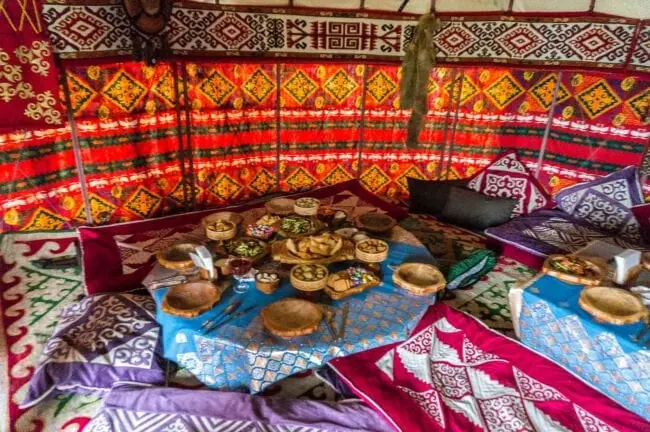
Live Music and Dance: Some restaurants, especially in larger cities, offer traditional Kazakh music and dance performances. These cultural shows can add to the ambiance of your meal. We had a particularly incredible evening at the home of our driver with his daughters (and their students) giving a live musical performance on traditional instruments like the incredible Dombra (like a two-string guitar).

Outdoor Dining: In pleasant weather, consider dining outdoors. Many restaurants offer garden or terrace seating with stunning views of the surrounding landscapes or ornate fountains. Almaty has really amazing weather in the shoulder seasons which makes outdoor dining a dream, but even on the hottest days, you can usually enjoy outdoor dining in the evenings.

Dining Etiquette and Customs:
Hospitality: Kazakh hospitality is renowned and deeply rooted in the hospitality of traditional nomadic cultures. When invited into a Kazakh home or yurt, it’s customary to bring a small gift, such as sweets or fruits, as a token of appreciation. Your host may enjoy a bottle of wine or vodka, even though the majority are Muslim, alcohol is usually acceptable, but you should know your host.
Shoes Off: In traditional settings like yurts and homes, it’s common to remove your shoes before entering.
Seating Arrangements: Typically, guests are seated on the floor or on low cushions around a table. Follow the lead of your hosts in terms of seating and posture.
Sharing Dishes: Kazakh meals often involve sharing dishes with those around you. It’s polite to take only what you can eat to avoid wasting food.
Toasting: When sharing a meal, expect to participate in toasts. Raising your glass and taking a sip is a sign of respect. If you’re offered a toast, it’s customary to reciprocate. Expect a lot of toasts and shots of vodka or other hard drink.
Special Dining Experiences:
Cooking Classes: Consider taking a cooking class to learn how to prepare traditional Kazakh dishes. It’s a hands-on way to appreciate the culinary traditions here and to bring those recipes and knowledge back home with you. Some of my favorite dishes to cook at home are things that I’ve picked up on the road, although I still haven’t made any Baursak at home.
Nomadic Experiences: In rural areas, some tour operators offer nomadic experiences like archery, acrobatic horse shoes, falconry, traditional instruments or the harvesting wool and these experiences often include dining with Kazakh families and participating in activities.
Tea Ceremonies: Kazakh tea culture is rich and diverse. Participate in a traditional tea ceremony to learn about the customs and enjoy a variety of teas and snacks.

By embracing these dining experiences and observing the etiquette and customs, you’ll not only savor the delicious flavors of Kazakhstan but also gain a deeper understanding of the country’s rich cultural tapestry. So, let your taste buds and your curiosity lead the way as you embark on your culinary journey through this extraordinary land.
Vegetarian and Dietary Considerations
While Kazakhstan’s culinary landscape is a paradise for meat lovers, travelers with dietary restrictions, such as vegetarians and vegans, may find it a bit challenging to navigate. Here’s a word of caution: Kazakh cuisine is traditionally meat-heavy, and vegetarian options can be limited in some areas. However, with a bit of effort and flexibility, you can still enjoy a satisfying meal in Kazakhstan.
Vegetarian and Vegan Options:
Laghman and Manti: In larger cities like Almaty and Astana, you can often find vegetarian versions of Laghman (noodle stir-fry) and Manti (dumplings) made with vegetable fillings, such as mushrooms and bell peppers.
Salads: Many Kazakh restaurants offer a variety of salads, such as “Olivier” salad (a Russian-inspired potato salad) or fresh vegetable salads.


Samsa with Pumpkin: Look for samsa filled with pumpkin, especially in the southern regions. These are a delightful vegetarian snack.
Fruit: One thing that almost any Kazakh table is never missing is a giant bowl of fruit at the center. You can definitely get your fill here as it often remains nearly untouched. Did you know the apple is originally from Almaty?

Bread and Dairy: Traditional Kazakh bread is typically vegetarian and can be a staple of your diet (it was for me, and I’m not even vegetarian!). You can also enjoy dairy products like yogurt, cheese, and horse and camel milk.

Accommodation and Communication:
Communicate Your Dietary Needs: When dining out, don’t hesitate to communicate your dietary preferences clearly to the staff. While English may not be widely spoken, having print outs in Russian and Kazakh with simple phrases like “I am vegetarian” or “I do not eat meat” can help convey your needs.
Cook For Yourself: Consider staying in accommodations with kitchen facilities, such as Airbnb apartments or guesthouses, to prepare your own meals when vegetarian options are limited. It’s often one of the best ways to save money too, if you’re traveling on a budget, although Kazakhstan isn’t too expensive.
Regional Variations:
Almaty and Astana: The capital and largest city, Astana, and the cultural hub of Almaty tend to offer more diverse dining options, including international cuisines, fine-dining, and vegetarian-friendly restaurants.

South Kazakhstan: In the south, where there is a significant Uzbek influence, you may find more vegetarian-friendly options like vegetable plov (pilaf) and shashlik (grilled vegetables).
West Kazakhstan: If you’re a pescatarian, you’ll find some great seafood options closer to the Caspian Sea in places like Aktau.
Filling the Gaps:
Snack Smart: Keep vegetarian snacks like nuts, dried fruits, and energy bars handy when you’re on the go, you’ll find tons of nuts and dried fruits in the local markets like Almaty’s Green Bazaar, and all for very reasonable prices.
BYO*: In some cases, consider bringing your favorite vegetarian or vegan products from home if you have specific dietary preferences or restrictions.
While it’s definitely true that Kazakhs have a strong affinity for meat, your journey as a vegetarian or vegan traveler in Kazakhstan can still be rewarding. Embrace the opportunity to explore traditional vegetable-based dishes and be sure to communicate your dietary needs clearly to ensure a memorable and satisfying dining experience. You don’t want any of that precious horse meat going to waste over a misunderstanding.
Food Markets and Culinary Tours
To truly immerse yourself in the vibrant tapestry of Kazakh cuisine, there’s no better way than to explore the bustling food markets and take part in guided culinary tours or cooking classes. Here are some recommendations to enhance your culinary adventure in Kazakhstan.
Explore Local Food Markets:
Green Bazaar in Almaty: If you find yourself in Almaty, a visit to the Green Bazaar (Zelyony Bazaar) is a must. It’s not only one of the largest and oldest markets in the city tracing back to the days of the Silk Road but also a sensory feast. Wander through the labyrinthine alleys lined with stalls overflowing with fresh produce, spices, dried fruits, and local delicacies.

Engage with the friendly vendors, sample dried nuts, try traditional sweets, and soak in the vibrant atmosphere. The market is a treasure trove of Kazakh ingredients and flavors. Vendors are super friendly too, despite the language barriers. Green Bazaar is also a good place to pick up souvenirs and even do other shopping, if you need to. Don’t forget to swing over to the Rakhat chocolate factory a block or two away which dates back to Soviet times.

Central Food Markets: In other cities across Kazakhstan, you’ll discover central food markets offering a similar experience, albeit with regional variations. These markets are excellent places to witness daily life, taste local specialties, and purchase unique ingredients to try your hand at Kazakh cooking.
Guided Culinary Tours
For travelers who desire a deeper understanding of Kazakh cuisine and culture, I highly recommend exploring culinary tours led by knowledgeable local guides. My preferred tour provider, GetYourGuide, offers a selection of enriching culinary experiences in Almaty, where many tourists start their Kazakhstan adventure:
Almaty Food Tasting Tour: Embark on a guided food tasting tour in Almaty, where you can sample a wide range of Kazakh dishes and street food while learning about their cultural significance. Taste traditional pastries, samsa, shashlik, and more.

Cooking Class: Enroll in a cooking class to learn how to prepare Kazakh dishes under the guidance of a local chef. Get hands-on experience making dumplings (manty) or traditional bread (baursak).
Visit the Green Bazaar: Join a guided tour of the Green Bazaar to explore the market’s hidden gems and discover the secrets behind Kazakh spices and ingredients. You’ll have the chance to interact with vendors and sample their products.
These tours not only provide an opportunity to savor authentic Kazakh flavors but also offer insights into the cultural significance of the dishes and ingredients. Plus, you’ll have the chance to connect with fellow travelers who share your passion for food and adventure, and get better insights with the help of a guide who speaks your language.
Whether you’re exploring the colorful stalls of the Green Bazaar or getting hands-on in a cooking class, these culinary experiences will undoubtedly enhance your journey through Kazakhstan, allowing you to savor the flavors and traditions of this extraordinary land.

Conclusion
As I relive my culinary journey through Kazakhstan via this article, I can’t help but reflect on the incredible flavors, traditions, and experiences that have enriched my adventure in this remarkable country. Kazakhstan, with its vast landscapes and rich cultural heritage, has left an indelible mark on my wanderlust-driven heart, and I’m already yearning to return to explore it more in-depth since we were mostly in and around Almaty throughout the length of our trip.

Kazakh cuisine, though often overshadowed by its neighbors, is a treasure trove of flavors and history waiting to be discovered. From the savory depths of Beshbarmak to the delicate flavors of Manti, from the hidden gems of regional specialties to the unique and definitely unforgettable experiences of camel’s milk and mare’s milk, every dish tells a story of nomadic traditions and a culture that sat at the crossroads of global trade for thousands of years.

What makes Kazakh cuisine truly exceptional for adventure travelers like us is not just the food itself, but the immersive experiences that accompany it. From dining in traditional yurts under the vast Kazakh sky to savoring street food while mingling with locals in bustling markets, every meal is an adventure of its own. I’d been traveling for so long in Latin America that I kind of forgot what it was like to travel in a place where I struggled to communicate, not knowing the local language, and felt my own wanderlust being rekindled at the unexpected magic that comes with being open to totally new experienced and giving yourself up to wherever the day takes you.
I wholeheartedly encourage you to embark on your own adventure in Kazakhstan. Whether you’re a seasoned traveler or new to the world of exploration, this country has something extraordinary to offer. Take a journey to the Caspian Sea’s shimmering shores to eat cavier, witness the majesty of a Russian rocket launch in Baikonur, embrace the nostalgia of riding old Soviet trains across the Kazakh Steppe, and stand in awe of snow capped peaks that beckon people like me to stand upon their summits.

My newfound love for Kazakhstan runs deep, and I can’t wait to return to uncover more hidden culinary gems, explore new landscapes, and create even more memories that will last a lifetime. This is a land of endless possibilities, a place where adventure meets gastronomy, and where every traveler can find their own unique path.
So, pack your bags, bring your appetite, and set your sights on Kazakhstan. Your next adventure awaits, and I promise you won’t be disappointed.
This publication was made possible through support provided by USAID’s Trade Central Asia activity, implemented by DAI, Travel Kazakhstan, and SATW’s Digital Publisher’s Council. The opinions expressed herein are those of the author(s) and do not necessarily reflect the views of the U.S. Agency for International Development, Travel Kazakhstan, or SATW.
Tips to Book Your Trip Now & Save Money
Book Your Flight
Book a cheap flight with Momondo, they’re my favorite search engine. Or better yet, start travel hacking so you can fly for free. Another great search engine is Skyscanner.
Book Your Accommodation
Book cheap accommodation in advance. For hostels I recommend HostelWorld, for hotels I use Booking.com or Hotels.com, and for apartments or longer stays, I use Airbnb. I like to check reviews on TripAdvisor prior to reserving.
Don’t Forget Travel Insurance
This is easy to overlook but SO important. It will help protect yourself from illness, injury, and theft while traveling. VERY important. And be sure to read my article about international travel insurance for more details
- SafetyWing (best for digital nomads)
- World Nomads (most comprehensive)
Looking for the Best Companies to Save Money With?
Check out my budget travel resources page for the best companies to use when traveling. I list all the ones I use and recommend to save money when I’m on the road.
Ryan
Latest posts by Ryan (see all)
- Kazakhstan Food: Exploring Some of its Most Delicious Dishes - August 7, 2023
- A Self-Guided Tour of Kennedy Space Center: 1-Day Itinerary - August 2, 2022
- Fairfield by Marriott Medellin Sabaneta: Affordable and Upscale - July 25, 2022
- One of the Coolest Places to Stay in Clarksdale MS: Travelers Hotel - June 14, 2022
- Space 220 Restaurant: Out-of-This-World Dining at Disney’s EPCOT - May 31, 2022

